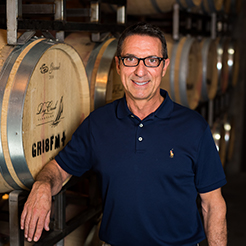Please download media information and marketing materials relating to our wines via the links below. If you have any questions or would like additional resources, please email trade@drycreekvineyard.com.


Regional Sales Director – Central
AR, IL, IN, IA, KS, KY, MI, MN, MO, NE, ND, OH, SD, TN, WI
Arkansas
Southern Glazer’s Wine & Spirits | (501) 955-2903
Illinois
Louis Glunz Wines, Inc. | (847) 793-0800
Market Place Selections | (309) 589-0575
Indiana
Southern Glazer’s Wine & Spirits | (317) 614-3211
Iowa
Southern Glazer’s Wine & Spirits | (800) 475-9463
Kansas
Southern Glazer’s Wine & Spirits | (913) 396-5500
Kentucky
Southern Glazer’s Wine & Spirits | (502) 297-6000
Michigan
Great Lakes Wine & Spirits | (313) 453-2200
H. Cox & Son, Inc. | (800) 748-0062
Minnesota
Breakthru Beverage | (651) 646-7821
Missouri
Southern Glazer’s Wine & Spirits | (636) 925-8800
Nebraska
Johnson Brothers of Nebraska | (402) 331-2200
North Dakota
Johnson Brothers – Northwest Beverage | (701) 282-4660
Ohio
Southern Glazer’s Wine & Spirits | (614) 552-7900
South Dakota
Johnson Brothers Famous Brands | (605) 336-2828
Tennessee
Southern Glazer’s Wine & Spirits | (901) 363-5555
Empire Wine & Spirits – Chattanooga | (423) 899-3962
Empire Wine & Spirits – Nashville | (615) 320-7292
Knoxville Beverage | (865) 637-9411
Wisconsin
Breakthru Beverage | (262) 874-2052

Delaware
Prestige-Ledroit Distributing Co. | (410) 439-1602
Maryland
Prestige-Ledroit Distributing Co. | (410) 439-1602
North Carolina
Mutual Distributing of Raleigh | (919) 828-3842
South Carolina
Southern Glazer’s Wine & Spirits of Columbia | (800) 577-0749
Southern Glazer’s Wine & Spirits of Charleston | (843) 747-2771
Southern Glazer’s Wine & Spirits of Myrtle Beach | (843) 236-1721
Virginia
Blue Ridge Beverage | (540) 380-2000
Robins Cellars | (804) 262-9463
Virginia Imports | (703) 823-1230
Washington, DC
Prestige-Ledroit Distributing Co. | (410) 439-1602
West Virginia
Can Am | (304) 842-6231

Regional Sales Director – East
AL, CT, FL, GA, MA, ME, MS, NH, NJ, NY, RI, PA, VT
Alabama
Pinnacle Imports, Inc. | (205) 428-8378
Connecticut
Worldwide Wines of NY, Inc. | (203) 239-4901
Florida
Southern Glazer’s Wine & Spirits | (305) 625-4171
Georgia
Republic National Distributing Company | (404) 472-2286
Massachusetts
Martignetti Companies | (781) 348-8000
Maine
Pine State Trading Company | (207) 622-3741
Mississippi
Southern Glazer’s Wine & Spirits | (601) 607-4107
New Hampshire
Pine State Trading Company | (800) 873-3825
New Jersey
Fedway Associates | (973) 624-6444
New York
Southern Glazer’s Wine & Spirits | (516) 921-9005
Rhode Island
Mancini Beverage | (401) 822-6400
Pennsylvania
Southern Glazer’s Wine & Spirits | (610) 265-6800
Vermont
Farrell Distributing | (800) 639-2875

National Accounts Director
AZ, CO, LA, NM, OK, TX
Arizona
Southern Glazer’s Wine & Spirits | (602) 533 8000
Colorado
Southern Glazer’s Wine & Spirits | (303) 292-1711
Louisiana
Southern Glazer’s Wine & Spirits | (504) 443-8600
New Mexico
Southern Glazer’s Wine & Spirits of Santa Fe | (505) 246-3160
Southern Glazer’s Wine & Spirits of Albuquerque | (505) 247-4186
Oklahoma
Southern Glazer’s Wine & Spirits | (918) 664-3347
Texas
Southern Glazer’s Wine & Spirits Farmer’s Branch | (972) 277-2000
Southern Glazer’s Wine & Spirits Dallas | (972) 392-8200

Regional Sales Director – West
AK, CA, HI, ID, MT, NV, OR, UT, WA, WY
Alaska
Specialty Imports | (907) 563-9100
California
Wine Warehouse – North | (800) 339-1410
Wine Warehouse – South | (800) 331-2829
Pacini Wines | (707) 468-0950
Hawaii
Southern Glazer’s Wine & Spirits | (808) 591-8825
Idaho
BRJ Wine Cellars | (208) 377-0017
Montana
Briggs Distributing Company, Inc. | (406) 252-2878
Bronken’s | (406) 586-2011
Summit Beverage | (406) 541-3900
Nevada
Southern Glazer’s Wine & Spirits – Las Vegas | (702) 876-4500
Southern Glazer’s Wine & Spirits – Reno | (775) 690-6292
Oregon
Southern Glazer’s Wine & Spirits | (503) 855-1041
Utah
Republic National Distributing Company | (801) 886-0096
Washington
Southern Glazer’s Wine & Spirits | (425) 629-2102
Wyoming
Republic National Distributing Company | (307) 777-6457

Brazil
Palato | Felipe Lacete
import.3064@palato.com.br
Belgium
Intervinos | Nico Terry
nico@intervinos.be
Bermuda
Burrows Lightbourn | Kevin Rhyno
krhyno@bll.bm
Canada
Alberta, British Columbia & Manitoba: Bacchus | Jamie Schnurr
jschnurr@bacchusgroup.ca
Ontario: Wine Lovers Agency Inc. | Anne Theriault
anne@wineloversagency.com
Quebec: Agence Vignome/Purovino | Jordan Thessereault
jordan@purovino.ca
Denmark
Glud Vin | Jorgen Glud
jg@gludvin.dk
Germany
Weinimport Aumüller | Ludwig Aumüller
la@aumueller.net
India
Monika Wines | Shanti Chandat
shanti.chandat@monikaenterprise.in
Japan
Tokuoka | Tatsuo Hayashi
t-hayashi@malps.co.jp
Korea
Plateau Wine Trading | Sanghun Yeo
sanghun.yeo@plateauwine.com
Netherlands
Luiten Importeur van kwaliteitswijnen | Gertjan Luiten
gertjan@luitenwijn.nl
Poland
WinoSFera | Monika Kwapisz
monika.kwapisz@interconsult.pl
Puerto Rico
B. Fernández & Hnos., Inc. | Maria Acevedo
maria.acevedo@bfernandez.com
Singapore
Angra Wines | Giacomo Pallesi
giacomo@angra.com.sg
St. Lucia
La Catina | Michael Thom
maj@casalucia.com
United Kingdom
Bibendum | Louise Wood
LouiseWood@matthewclark.co.uk
Airlines
Intervine | Shany Chaaban
Shany.Chaaban@intervineinc.com
Cruise Lines
Alexander James | Iggy Melero
ignacio@alexanderjames.com
Select link below to download asset
Dry Chenin Blanc – Food & Wine
NV Dry Chenin Blanc
2023 Dry Chenin Blanc – 91 Points, Best Buy, Wine Enthusiast
2023 Dry Chenin Blanc – 91 Points, Wine Spectator
2023 Dry Chenin Blanc – 91 Points, James Suckling
2023 Dry Chenin Blanc – 93 Points, Double Gold, OC Fair Wine Competition
2021 Dry Chenin Blanc – 96 Points, Double Gold, Best of Show White Wine – Sunset International Wine Competition
2020 Dry Chenin Blanc – 90 Points, Wine Enthusiast
2023 Dry Chenin Blanc Recommended in Wine Spectator
2023 Dry Chenin Blanc in Wine Spectator Sips & Tips
Dry Chenin Blanc – Food & Wine
NV Dry Chenin Blanc
2023 Dry Chenin Blanc – 91 Points, Best Buy, Wine Enthusiast
2023 Dry Chenin Blanc – 91 Points, James Suckling
2023 Dry Chenin Blanc – 91 Points, Wine Spectator
2023 Dry Chenin Blanc – 93 Points, Double Gold, OC Fair Wine Competition
2022 Dry Chenin Blanc – Gold – San Francisco Chronicle Wine Competition
2022 Dry Chenin Blanc – Gold – Sunset International Wine Competition
2022 Dry Chenin Blanc – New Release
Select link below to download asset
NV Fumé Blanc
2023 Fumé Blanc – 90 Points – Wine Enthusiast
2023 Fumé Blanc – 90 Points – Wine Spectator
2023 Fumé Blanc – Double Gold – Sunset International Wine Competition
2023 Fumé Blanc – 92 Points, James Suckling
2022 Fumé Blanc – 90 Points – Wine Spectator
2021 Fumé Blanc – 90 Points, Editors’ Choice – Wine Enthusiast
2021 Fumé Blanc – 90 Points, Gold – Sunset International Wine Competition
NV Fumé Blanc
Wine Spectator 2025 Sauvignon Blanc Report
2023 Fumé Blanc – 90 Points – Wine Enthusiast
2023 Fumé Blanc – 90 Points – Wine Spectator
2023 Fumé Blanc – 92 Points – James Suckling
2023 Fumé Blanc – Double Gold – Sunset International Wine Competition
2023 Fumé Blanc – New Release
2022 Fumé Blanc – 90 Points – Wine Spectator
2022 Fumé Blanc – Gold – Dan Berger’s International Wine Competition
2022 Fumé Blanc – Double Gold – Sonoma County Harvest Fair
2022 Fumé Blanc – Gold – Sunset International Wine Competition
2022 Fumé Blanc – New Release
2021 Fumé Blanc – 90 Points, Editors’ Choice – Wine Enthusiast
2021 Fumé Blanc – 90 Points, Gold – Sunset International Wine Competition
2021 Fumé Blanc – Platinum Medal – TEXSOM
Select link below to download asset
NV Sauvignon Blanc
DCV Sauvignon Blanc – Wine Spectator Top 10 Values of 2024
Wine Spectator 2025 Sauvignon Blanc Report
2023 Sauvignon Blanc – 92 Points – Wine Spectator
2023 Sauvignon Blanc – 90 Points – James Suckling
2023 Sauvignon Blanc – 99 Points – California State Fair
2023 Sauvignon Blanc – New Release
2022 Sauvignon Blanc – 93 Points – Wine Enthusiast
2022 Sauvignon Blanc – Double Gold – Sunset International Wine Competition
2022 Sauvignon Blanc – New Release
Select link below to download asset
NV DCV Block 10 Chardonnay
2022 DCV Block 10 Chardonnay – 92 Points, James Suckling
2022 DCV Block 10 Chardonnay – 91 Points – Wine Enthusiast
2019 DCV Block 10 Chardonnay – 90 – Wine Enthusiast
2019 DCV Block 10 Chardonnay – 90 Points – Wine & Spirits
2019 DCV Block 10 Chardonnay – 90 Points – Jeb Dunnuck
2019 DCV Block 10 Chardonnay – 91 Points – North Coast Wine Challenge
2018 DCV Block 10 Chardonnay – 90 Points – Wine Enthusiast
2018 DCV Block 10 Chardonnay – 90 Points – CA Grapevine
NV DCV Block 10 Chardonnay
2022 DCV Block 10 Chardonnay – 92 Points – James Suckling
2022 DCV Block 10 Chardonnay – 91 Points – Wine Enthusiast
2021 DCV Block 10 Chardonnay – New Release
2020 DCV Block 10 Chardonnay – New Release
2019 DCV Block 10 Chardonnay – 90 Points – Wine Enthusiast
2019 DCV Block 10 Chardonnay – 90 Points – Wine & Spirits
2019 DCV Block 10 Chardonnay – 90 Points – Jeb Dunnuck
2019 DCV Block 10 Chardonnay – 91 Points – North Coast Wine Challenge
Select link below to download asset
NV Heritage Vines Zinfandel
2022 Heritage Vines Zinfandel – 91 Points – Wine Enthusiast
2021 Heritage Vines Zinfandel – 91 Points – Wine Spectator
2021 Heritage Vines Zinfandel – 91 Points – Wine Enthusiast
2020 Heritage Vines Zinfandel – 93 Points – Wine Enthusiast
2019 Heritage Vines Zinfandel – 91 Points – Wine Spectator
2019 Heritage Vines Zinfandel – 92 Points, Editors’ Choice – Wine Enthusiast
NV Heritage Vines Zinfandel
2022 Heritage Vines Zinfandel – 91 Points – Wine Enthusiast
2022 Heritage Vines Zinfandel – New Release
2021 Heritage Vines Zinfandel – Haute Living
2021 Heritage Vines Zinfandel – 91 Points – Wine Spectator
2021 Heritage Vines Zinfandel – 91 Points – Wine Enthusiast
2021 Heritage Vines Zinfandel – Gold – Dan Berger’s International Wine Competition
2021 Heritage Vines Zinfandel – Double Gold – Sonoma County Harvest Fair
2021 Heritage Vines Zinfandel – As Seen on Squawk Box
2021 Heritage Vines Zinfandel – New Release
2020 Heritage Vines Zinfandel – 93 Points – Wine Enthusiast
Heritage Vines Zinfandel – 90+ Point History – Wine Spectator
Select link below to download asset
NV Old Vine Zinfandel
2021 Old Vine Zinfandel – Gold – Sunset International Wine Competition
2021 Old Vine Zinfandel – 93 Points – James Suckling
2021 Old Vine Zinfandel – 92 Points – Wine Spectator
2021 Old Vine Zinfandel – 92 Points – Wine Enthusiast
2020 Old Vine Zinfandel – 94 Points – Wine Enthusiast
NV Old Vine Zinfandel
2022 Old Vine Zinfandel – New Release
2021 Old Vine Zinfandel – Gold – Sunset International Wine Competition
2021 Old Vine Zinfandel – 92 Points – Wine Spectator
2021 Old Vine Zinfandel – 92 Points – Wine Enthusiast
2021 Old Vine Zinfandel – Triple Gold, Best of Class – Dan Berger’s International Wine Competition
2021 Old Vine Zinfandel – Gold – San Francisco Chronicle Wine Competition
2021 Old Vine Zinfandel – Gold – Sonoma County Harvest Fair
2021 Old Vine Zinfandel – New Release
2020 Old Vine Zinfandel – 94 Points – Wine Enthusiast
2020 Old Vine Zinfandel – New Release
Class – California State Fair
2019 Old Vine Zinfandel – Gold – San Francisco Chronicle Wine Competition
Select link below to download asset
Select link below to download asset
Select link below to download asset
Select link below to download asset
2021 The Mariner – 92 Points – Wine Enthusiast
2019 The Mariner – Double Gold – OC Fair
2019 The M
ariner – 93 Points – James Suckling
2019 The Mariner – 90 Points – Wine Spectator
2019 The Mariner – 91 Points – Wine Enthusiast
NV The Mariner
2019 The Mariner – 95 Points, Double Gold, Best of Class – Sunset International Wine Competition
2018 The Mariner – 90 points – Wine Enthusiast
2017 The Mariner – 95 points – North Coast Challenge
2017 The Mariner – 93 points – WineReviewOnline
2017 The Mariner – 91 points – CA Grapevine
2021 The Mariner – 92 Points – Wine Enthusiast
2021 The Mariner – 95 Points – James Suckling
2021 The Mariner – Double Gold – OC Fair
2019 The Mariner – 93 Points – James Suckling
2019 The Mariner – 90 Points – Wine Spectator
2019 The Mariner – 91 Points – Wine Enthusiast
NV The Mariner
2019 The Mariner – New Release
2019 The Mariner – 95 Points, Double Gold, Best of Class – Sunset International Wine Competition
2019 The Mariner – 93 Points, Best of Class – California State Fair
2018 The Mariner – 90 points – Wine Enthusiast
2018 The Mariner – Gold – San Francisco Chronicle Wine Competition
2017 The Mariner – 95 points – North Coast Challenge
2017 The Mariner – 93 points – WineReviewOnline
Select link below to download asset
2021 Endeavour Cabernet Sauvignon – 94 Points – Wine Enthusiast
2021 Endeavour Cabernet Sauvignon – 93 Points – James Suckling
2021 Endeavour Cabernet Sauvignon – New Release
2019 Endeavour Cabernet Sauvignon – 94 Points – Wine Enthusiast
2019 Endeavour Cabernet Sauvignon – 93 Points – James Suckling
2019 Endeavour Cabernet Sauvignon – New Release
Select link below to download asset
Select link below to download asset
Select link below to download asset
Select link below to download asset
Select link below to download asset
Select link below to download asset
Select link below to download asset
Select link below to download asset
Select link below to download asset
Select link below to download asset
Select link below to download asset
Select link below to download asset
Select link below to download asset
Select link below to download asset
Select link below to download asset
Select link below to download asset
Select link below to download asset
Select link below to download asset
Select link below to download asset
Select link below to download asset
Select link below to download asset
Select link below to download asset
Select link below to download asset
Select link below to download asset
Select link below to download asset
Select link below to download asset
Select link below to download asset
Select link below to download asset